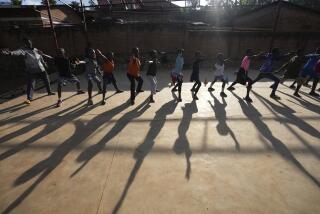Local Expert at Home With Nomads
- Share via
The find was stunning. More than 150 ancient graves were strung along the border of Russia and Kazakhstan, filled with skeletons of women flanked by swords, iron daggers, arrowheads and leather quivers.
The implications weren’t lost on Jeannine Davis-Kimball, the Ventura archeologist who was excavating the site. The expert on central Asian nomads had studied history. She knew the story of the Amazons, female warriors who reportedly killed their male children, shunned traditional women’s roles and were crack shots with the bow and arrow.
As tantalizing as the find was, Davis-Kimball said the remains probably were not Amazons--they were too far from the Black Sea. But she believes these fighting female nomads, who lived about 600 BC, helped fuel the Amazon stories.
“I believe we had women warriors evolve to protect the herds when the men were gone,” she said. “But they were not out raping and pillaging like Genghis Khan.”
Davis-Kimball has lived with nomads in Mongolia, studied their trade routes through Afghanistan and examined their mummified bodies in western China.
What she has learned has been the subject of five documentaries, numerous articles and five books, the newest titled “Warrior Women, An Archeologist’s Search for History’s Hidden Heroines.”
The book was prompted by the excavations of Sauromatian graves in southern Russia between 1992 and 1995. Other tribes of the area, such as the Sarmatians and Scythians, also had women warriors, along with women priests, politicians and homemakers.
“The women in these nomadic cultures were incredibly strong and had a much bigger impact politically and economically than we realized,” Davis-Kimball said.
Saw First Nomads on Stone Reliefs
It was this independence and pluck that drew her to central Asian nomads. She saw her first nomads carved on stone reliefs in the ruins of Persepolis, Iran. She later sought out the real thing on the steppes of Russia, Kazakhstan and the Altai Mountains of Mongolia.
“I wanted to develop an understanding of the nomadic way of life as it was lived 2,500 years ago and it was still very much the same,” she said. “These were tough women. I was impressed with their calmness, peacefulness and their impeccable hospitality to strangers.”
Gary Marcuse, a documentary filmmaker from Canada, recently worked with the archeologist on a program called “Ancient Clues” for the Discovery Channel.
“We put her on a boat and dropped her on the shore of the Sea of Azov,” the northern arm of the Black Sea, Marcuse said. “The purpose was to re-create the path of Jeannine’s research to show there were women warriors among the Sauromatians. We were also following in the footsteps of the Amazons.”
Marcuse spent two weeks with Davis-Kimball, hiking through plains and mountains in sweltering heat.
“She is extremely good at making this stuff interesting,” he said. “We never stopped talking.”
Suzanne Lettrick, formerly Davis-Kimball’s assistant at the Center for the Study of Eurasian Nomads in Berkeley, recalled a 1998 trip to Mongolia where Davis-Kimball hoped to unearth the frozen body of a nomadic priestess rumored to be buried there. They dug for two months but found nothing.
“We had a makeshift toilet with plastic bags tied around four wooden posts and a hole in the ground,” said Lettrick, who now lives in Los Angeles. “We were really out there. Jeannine lives for that kind of stuff.”
Davis-Kimball grew up among the horses and mountains of southern Idaho before moving to Ventura in 1963. A nurse who raised six children, she made a midlife career change in 1983, returning to college to study art history.
“I was always interested in art history and became interested in ancient art history,” she said. “And that’s what took me to archeology.”
She began at Ventura College, then transferred to Cal State Northridge and got her bachelor’s degree in art history. She later received a master’s and doctorate in history and archeology from Berkeley.
In 1989, she founded and became executive director of the Center for the Study of Eurasian Nomads.
Davis-Kimball participated in a 1999 Nova documentary called “Mysterious Mummies of China,” where she helped investigate the origins of Caucasian mummies found in western China.
Time Now Given to Institute’s Web Site
She found a huge petroglyph in the mountains of China depicting a fertility ritual. It was similar to a pottery carving she found during a dig in Moldova. The mummies, she believes, were nomads from southern Russia and the Ukraine who grazed their herds in the rich pastures of China.
These days, Davis-Kimball spends much of her time working on her institute’s Web site--https://csen.org--where various scholars post papers and reviews. She also spends time with her husband, children, nine grandchildren and six great-grandchildren.
The silver-haired scientist, who won’t divulge her age, shows no signs of slowing down.
Asked if she believes there really were Amazons, she pauses a moment.
“I have no reason to believe the Amazons ever existed,” she said. “But we have reason to believe the ancient Greeks drew upon societies they knew to come up with the Amazon story.”
More to Read
Sign up for Essential California
The most important California stories and recommendations in your inbox every morning.
You may occasionally receive promotional content from the Los Angeles Times.










